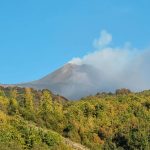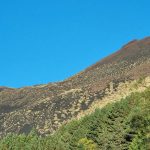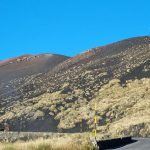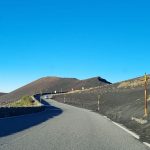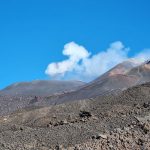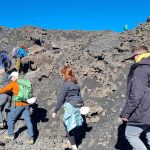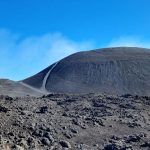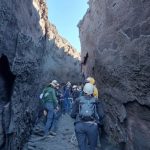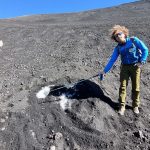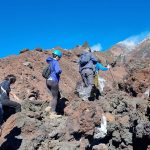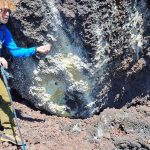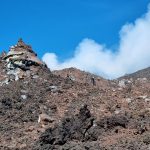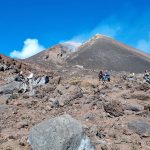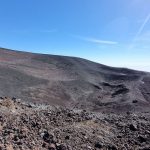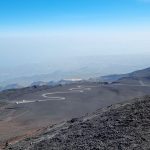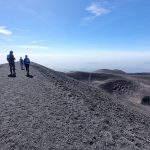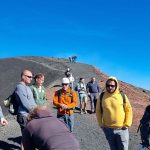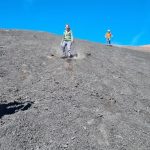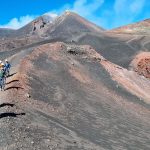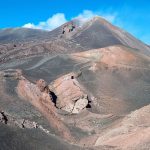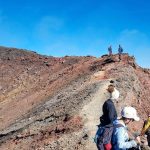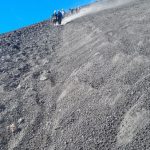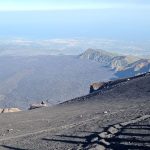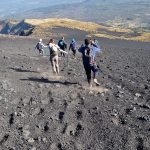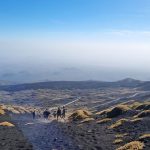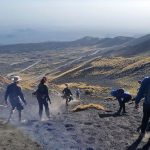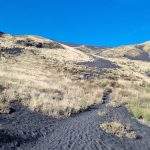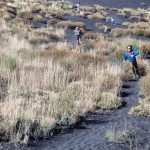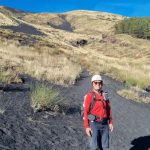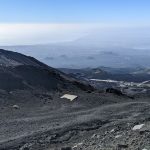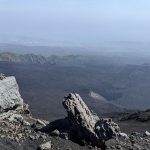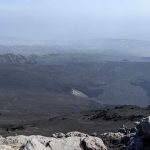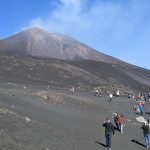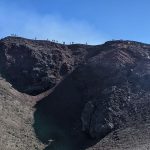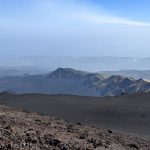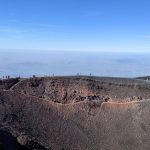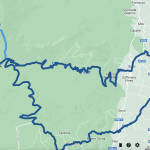Tuesday 25th October 2022
Another early start for us today. We are climbing Mt Etna and need to be at the meeting point at 2000m by 8.45am and our home in Santa Venerina is at least a 38min drive on many bends and narrow Sicilian roads. Sop we left home at 7.30am packed for a big day as the tour goes for at least 5 hours. Unfortunately David woke up a little unwell, so wasn’t sure if he could manage the hike. So we drove to the start , discussed his options with the tour company – Aitne, tour guide – Francesco, and he decided to travel up on the cable car and return (30 euro each). On the cable car we met an Italian guy and his wife who after chatting for a couple of mins we found out that he had lived and worked as a chef in Castlecragh for 6 years. So uncanny, what a small world we live in. Castlecrag is 5mins from our home in Willoughby. He couldn’t believe it either. He now lives in Italy.
In the end David did this little tour – Climb Mount Etna in an off-road vehicle and walk among the extinct craters and lava flows in the company of an expert guide who will tell you all the secrets of Europe’s largest active volcano. You will admire incredible landscapes while exploring one of Sicily’s most iconic places. (38 euro)
This is the tour I. did – Trekking at 2900m: By cable car, the first uphill section is reached, reaching approximately 2500m. From there, via a route that avoids the most crowded areas, you reach on foot the altitude of 2900m where you find yourself in front of the craters and their life! To complete the understanding of the volcanic phenomena we visit the eruptive theater of the 2002-2003 eruption: its splendid craters and the impressive eruptive fissure. Finally a visit on the highest edge of Valle del Bovewhere to appreciate the evolutionary history of Etna with a stunning view.(45 euro). We learned a lot about the volcano, lava flow, explosive eruptions, and much more. All now in my memory bank for the next 30 seconds. It was a great hike up with a lovely view for lunch. On the way down we did some ash running/galloping down very steep slopes. You move forward, lean back and gallop down the hill. A very quick descent. Our tour group handled this very well, so we went on a steeper slope. We then arrived at the cable car where we split the group, some went down the cable car and the rest were offered to run down the next 600m elevation in 30 mins over a couple of kms. It was nuts and when I can’t walk in the next few days I will have to remember that I am not as young as I used to be. It was incredible to leap through the air and land, burying your feet about 15-30cms in the ash and then keep on bouncing down the hill. A very steep hill at that. We ran sometimes 3-400m in length at a time, sometimes 2-300, although it was very dusty. Each time we stopped we learned a bit more about Mt Etna.
We both had a great day, although I would have preferred we were together. My memory of the knowledge imparted by Francesco is limited but he was amazing, with a zest for life, volcanoes and the outdoors.
David at least got to see some craters and walk on Mt Etna and he probably retained more information from his guide than me.
It was a great day!
“Mount Etna, or simply Etna, is an active stratovolcano on the east coast of Sicily, Italy, in the Metropolitan City of Catania, between the cities of Messina and Catania. It lies above the convergent plate margin between the African Plate and the Eurasian Plate and is one of the highest volcano in Europe and one of the most active in the world. The volcano shaped the Sicilian history and landscape and still affects the island today. It is an UNESCO World Heritage site since 2013 and the smoking volcano craters and the old and new lava flows are always an impressive experience for visitors. It is 3,329 metres tall with a base circumference of about 150 kilometres.
With the cable car “Funivia” from Rifugio Sapienza you will reach about 2,500 metres. From there you will have two options, the first is, to join a guided hike in the volcanic area, known as the Valle del Bove up to 2900m and the second is a less strenuous tour with a 4×4 jeep ride to 2750m.
Mt. Etna is an active and constantly changing volcano as it is in a constant state of activity, a mystery of nature that fascinates everyone and makes us a little afraid too, with its explosions, the high lava fountains, earthquakes! The fertile volcanic soils support extensive agriculture, with vineyards and orchards spread across the lower slopes of the mountain and the broad Plain of Catania to the south.
Over a six-month period in 2021, Etna erupted so much volcanic material that its height increased by approximately 30 m, and the southeastern crater is now the tallest part of the volcano.
Eruptions of Etna follow multiple patterns. Most occur at the summit, where there are five distinct craters – the Northeast Crater, the Voragine, the Bocca Nuova, and two at the Southeast Crater Complex. Other eruptions occur on the flanks, which have more than 300 vents ranging in size from small holes in the ground to large craters hundreds of metres across. Summit eruptions can be highly explosive and spectacular but rarely threaten the inhabited areas around the volcano. In contrast, flank eruptions can occur down to a few hundred metres altitude, close to or even well within the inhabited areas. Numerous villages and small towns lie around or on cones of past flank eruptions. Since the year AD 1600, at least 60 flank eruptions and countless summit eruptions have occurred; nearly half of these have happened since the start of the 20th century. Beginning in February 2021, Mount Etna began a series of explosive eruptions, which have had an impact on nearby villages and cities, with volcanic ash and rock falling as far away as Catania. As of 12 March 2021, the volcano has erupted 11 times in three weeks. The eruptions have consistently sent ash clouds over 10 km into the air, closing Sicilian airports. There have been no reports of injuries.”
The story behind the Moors Head ceramic vase in the last picture below – “Teste di Moro. The legend behind these figures comes from the XI century when the Moors dominated Sicily and, like so many legends, is supposedly all the fault of Cupid.
One day, a girl who lived in the Arab district of Palermo, the Kalsa, was taking care of some plants and flowers on the balcony of her house. Suddenly, a dark-skinned merchant passed by and they immediately fell in love with one another. They began their love story together until the young girl discovered that her lover already had a wife and children waiting for him back in his home country.
One night while he slept, the girl, crazed with jealousy, thought of a way to make him stay with her forever! Without blinking an eye she cut off his head and decided to use it as a vase to grow her beautiful basil.
As people would walk by her balcony, they began to become jealous of her thriving basil, and so they began creating colorful vases with clay heads. Today there are many different styles of ceramics heads, but the most traditional are a man of colour and a beautiful girl.”
- Our first sighting of Mt Etna with forest in the foreground..
- The different colours of the terrrain of the surrounding volcanoes of Mt Etna..
- ..each bend in the road we see differrent colours and vegetation..
- ..until we come along these bends to no vegetation and ash covered mounds..
- ..as we drive in to the tourist village at 2000m with the chairlift in the background..
- ..as I start to climb Mt Etna, see the terrain, watch as it changes throughout the photos..
- ..my tour group as we continue up Mt Etna..
- ..the terrain gets tougher to walk on..
- ..each corner we turn the terrain looks different..
- ..as we walk through a lava tube..
- ..the lava tunnel..
- The different coloured volcanic rocks – this section the steam was still coming out of the rocks..
- ..the unusual shaped volcanic rock with the steep incline of Etna in the background..
- ..as the group continue up Mt Etna..
- ..Francesca showing us some ice that is still under the basalt rocks which enableit to stay frozen, it is from last winter..
- ..as we continue up, the terrain gets tougher..
- ..sulphur on a large rock which will eventually be washed away by rain..
- ..such different terrain in every direction you look..
- ..measuring the temperature of the rocks – about 400°C..
- ..a group heading back over the ridge, see all the different size rocks in the foreground..
- ..a close-up of Mt Etna..
- ..a stop for lunch at 2900m, unfortunately that is as far as we are able to go today..
- ..a photo at the 2900m elevation. That’s as high as the authorities will allow at the moment..
- ..looking across at some old craters..
- ..looking down to the bus tour trails, they go all day. See the crrated on the far right..
- ..as my group starts the descent, we still have a ridge to climb where the wind was howling..
- ..the down the other side of the ridge..
- ..time to learn how to run down the steep ash covered mountain, it was very steep, it is very soft and you sink very deep ..
- ..what amazing colours as we continue walking tdown the mountain..
- ..what amazing colours as we continue walking tdown the mountain..
- ..the fantastic colours of Mt Etna..
- ..looking up to the rocky slopes..
- ..our next steeper descent to run down, yeehah!
- ..each new run we get better and faster..
- ..such a barren, black ash trail..
- ..as we continue along the black ash trail..
- ..as the terrain changes below, see some more old craters..
- ..we continued running down at every opportunity..
- ..what beautiful colours..
- ..one of our last downhill runs, 700m descent over 2km in 30mins..
- ..Francesco our guide was in his element..
- ..he made it to the bottom..
- ..and so did I..
- ..Davids tour – looking down to the village and valley below..
- ..Mt Etna..
- ..David’s tour bus..
- ..and his tour group..
- ..looking down through volcanic rock to a crater..
- ..a crater..
- ..the bus group looking up to Mt Etna..
- ..the constant stream of ants march up the mountain..
- ..looking around the area..
- ..all the different trails up Mt Etna..
- Looking down into the valley, with lots of volcanic ash..
- Looking in to a crater
- The bus track up and looking towards Mt Etna..
- ..back at our apartment in Santa Venerina with Mt Etna in the background..
- ..Teste di Moro – these ceramic vases are all around Sicily, there is a story that goes with them – see above in the story..
- 47km round trip to Mt Etna along some incredibly narrow wild roads and a 12km hike for me.
